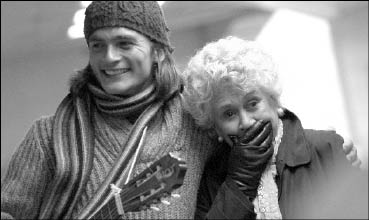Next story: Playing Hard is Hard Work: Cinnamon
It Ain't the Hotel California: Mrs. Palfrey at the Claremont
by George Sax

“I feel like I’ve been trapped in a Terence Rattigan play,” a character named Ludovic Meyer says at one point, not entirely in jest, in Mrs. Palfrey at the Claremont. If you’re old, or theatrically savvy, enough, the movie may make you feel a little like that yourself.
Rattigan’s dramas about middle-class alienation and the kind of crises that unfold in genteel circumstances were immensely popular with audiences from the late 1930s to the mid-1950s, after which they began to seem too socially and psychologically restrictive.
You may easily be forgiven for not knowing this, but you may share “Ludo’s” mild chronological disorientation and bemusement if you become part of the audience for Dan Ireland’s adaptation of Elizabeth Taylor’s novel of the same name. Ludo is sitting in the eponymous hotel’s dining room with Sarah Palfrey (Joan Plowright) when he makes the quip. She has recently moved into the London residential hotel in search of some kind of independent life and friendly surroundings. A widow in her mid-70s, she soon begins to understand what she’s got herself into.
The Claremont, like much of this movie, seems an anachronism, the kind of place one might assume scarcely existed anymore (roast beef on Sunday, bath down the hall). It seems to be inhabited by people of at least retirement age, of sufficient if not bountiful means. Most of them appear to have been forgotten by life.
Based on Sarah’s first impressions, companionability doesn’t seem likely at the Claremont. The hotel residents are stiffly reserved, or timid. They sit at separate tables in the dining room (a few people may now recall the title of one of Rattigan’s hits) and their infrequent communications are spoken loudly across the empty spaces. Mrs. Abruthnot (Anna Massey in a very able performance) is more forthcoming, if not necessarily encouraging. “Nobody ever dies at the Claremont,” she tells Mrs. Palfrey, but this is less than consoling, given the subtext of her message.
Mrs. Palfrey is about age and the changing, sometimes frightening, challenges of life’s passages, as well as intergenerational isolation and communication. The latter theme is introduced when Mrs. Palfrey meets Ludo (Rupert Friend), a young man who comes to her assistance after a small sidewalk mishap. Thus begins a surprising and mutually enriching friendship. Ludo is an aspiring writer and practicing street performer who plays the guitar and sings for pedestrian contributions. He is also a little too good to be true: handsome, clever, acutely sensitive to others, unaffectedly friendly but respectful. (His hardworking single mother doesn’t appreciate his unconventional life choices, but even this abrasive viewpoint is smoothed some by Mrs. Palfrey’s intervention.)
The movie’s tone and incidents are reminiscent not only of Rattigan; they also suggest an even older influence, that of the coy humor and sentimentality of J.M. Barrie. Mrs. Palfrey’s ostensible engagement with real human burdens, especially sorrow and loss, is diverted and reduced by its often mechanically impelled narrative and its emotional manipulation. It’s too deeply artificial, that is, shallowly sentimental, and curiously old-fashioned to really grab hold of any serious human problems. (I suspect Taylor’s novel dealt with these ideas more incisively.) The movie’s general tenor suggests Ireland directed cautiously and with an over-refined sensibility.
But his movie is smoothly professional and the performers sometimes manage to temporarily surmount its restrictions and predictability. Plowright and Friend occasionally achieve a joint synergism that vitalizes the more musty and treacly material.
Eventually, Mrs. Palfrey becomes a full-bore weepie, an intense pulp tragedy. There are two ways to respond to this kind of thing: disdain and avoid it, or succumb to its contrived appeal. This is no Driving Miss Daisy but I think there’s an audience for its skillful emotion mongering, especially in today’s cynically bombastic, exploitively explosive entertainment environment.
The movie’s appeal may be limited, but it is sincere and elicits genuine, if very transitory, human feeling.
Mrs. Palfry at the Claremont will play from March 1-6 only on the Emerging Cinema digital screen at the Market Arcade Film and Arts Center.
|
Issue Navigation> Issue Index > v5n48: Gray Anatomy (11/30/06) > Film Reviews > It Ain't the Hotel California: Mrs. Palfrey at the Claremont This Week's Issue • Artvoice Daily • Artvoice TV • Events Calendar • Classifieds |









 Current Issue
Current Issue